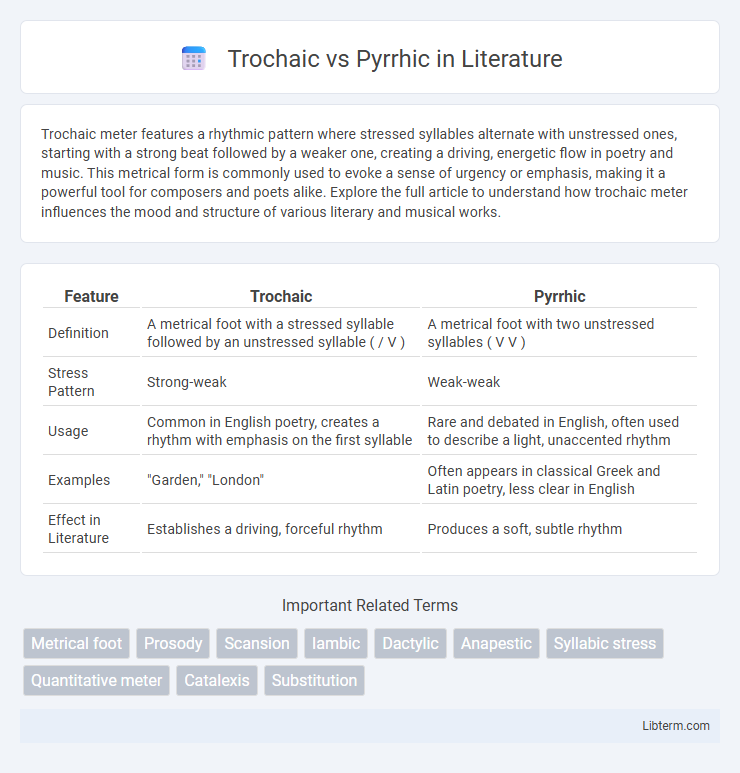Trochaic meter features a rhythmic pattern where stressed syllables alternate with unstressed ones, starting with a strong beat followed by a weaker one, creating a driving, energetic flow in poetry and music. This metrical form is commonly used to evoke a sense of urgency or emphasis, making it a powerful tool for composers and poets alike. Explore the full article to understand how trochaic meter influences the mood and structure of various literary and musical works.
Table of Comparison
| Feature | Trochaic | Pyrrhic |
|---|---|---|
| Definition | A metrical foot with a stressed syllable followed by an unstressed syllable ( / V ) | A metrical foot with two unstressed syllables ( V V ) |
| Stress Pattern | Strong-weak | Weak-weak |
| Usage | Common in English poetry, creates a rhythm with emphasis on the first syllable | Rare and debated in English, often used to describe a light, unaccented rhythm |
| Examples | "Garden," "London" | Often appears in classical Greek and Latin poetry, less clear in English |
| Effect in Literature | Establishes a driving, forceful rhythm | Produces a soft, subtle rhythm |
Introduction to Trochaic and Pyrrhic Meter
Trochaic meter is a rhythmic pattern in poetry consisting of a stressed syllable followed by an unstressed syllable, creating a falling cadence that is often used to convey emphasis and urgency. Pyrrhic meter, in contrast, features two consecutive unstressed syllables and is less common, mostly appearing as a metrical substitution within a line rather than forming entire metrical feet. Understanding the distinction between trochaic and pyrrhic meters aids in analyzing the rhythm and emotional tone of poetic verses.
Defining Trochaic Foot
A trochaic foot consists of a stressed syllable followed by an unstressed syllable, creating a rhythmic pattern commonly found in poetry and meter analysis. This metrical foot contrasts with the pyrrhic foot, which features two unstressed syllables in succession. Understanding the trochaic foot is essential for analyzing verse structure and stress patterns in English poetry.
Understanding the Pyrrhic Foot
The pyrrhic foot in poetry consists of two unstressed syllables, creating a light and subtle rhythmic effect that contrasts with more common metrical feet like the trochaic, which features a stressed syllable followed by an unstressed one. Understanding the pyrrhic foot enhances the analysis of poetic meter by highlighting moments of softness or hesitation within a line, often used to vary the tempo or mood. Its rarity and nuanced use require careful scansion to distinguish from other metrical patterns, making it a vital concept for in-depth poetic study.
Key Differences Between Trochaic and Pyrrhic
Trochaic meter consists of a stressed syllable followed by an unstressed syllable, creating a falling rhythm commonly used in poetry and song. Pyrrhic meter features two consecutive unstressed syllables, often acting as a transitional or filler foot in iambic or trochaic verse. The key difference lies in stress placement: trochaic feet emphasize the first syllable, while pyrrhic feet lack any stress, affecting the overall rhythm and mood of the verse.
Trochaic Meter in Poetry Examples
Trochaic meter features a stressed syllable followed by an unstressed one, creating a rhythmic pattern common in poetry such as Henry Wadsworth Longfellow's "The Song of Hiawatha." This meter contrasts with the pyrrhic foot, which consists of two unstressed syllables and is less frequently used as a dominant pattern. Poets often employ trochaic meter to convey a strong, driving rhythm that emphasizes a downbeat, enhancing the emotional impact and musicality of their verses.
Pyrrhic Foot Usage in Literature
The Pyrrhic foot, consisting of two unstressed syllables, is rarely used as a standalone metric element but often appears within larger metrical patterns to create rhythmic variation in poetry. Renowned poets like Alexander Pope and Lord Byron occasionally employed pyrrhic feet to subtly emphasize a shift in tone or pace, enhancing the emotional impact of their verses. This metrical tool provides a nuanced approach to rhythm, distinguishing it from the more common and forceful trochaic foot, which features a stressed syllable followed by an unstressed one.
Identifying Trochaic and Pyrrhic in Verses
Trochaic feet consist of a stressed syllable followed by an unstressed syllable, often creating a falling rhythm, as in the word "garden." Pyrrhic feet are composed of two unstressed syllables and are rare in English poetry, typically found within a line rather than standing alone. Identifying trochaic verses involves looking for consistent stressed-unstressed patterns, while pyrrhic feet require attention to localized pairs of unstressed syllables amidst a metrical line.
The Role of Rhythm in Poetic Structure
Trochaic and pyrrhic meters play distinct roles in shaping a poem's rhythmic foundation, influencing its emotional impact and flow. Trochaic meter, characterized by a stressed syllable followed by an unstressed syllable, often creates a driving, emphatic rhythm that heightens intensity. In contrast, pyrrhic meter, consisting of two unstressed syllables, introduces subtle variation and softness, providing contrast and nuanced pacing within poetic lines.
Effects on Tone and Mood: Trochaic vs Pyrrhic
Trochaic meter, with its stressed-unstressed pattern, creates a driving, emphatic rhythm that often conveys a forceful or urgent tone, enhancing feelings of assertiveness or intensity in poetry. Pyrrhic meter, consisting of two unstressed syllables, generates a softer, more subdued rhythm that can introduce subtlety or ambiguity, contributing to a mood of calmness or uncertainty. The contrast between trochaic and pyrrhic meters significantly impacts a poem's emotional atmosphere by shaping its auditory dynamics and reader perception.
Summary and Importance in Poetic Analysis
Trochaic meter features a stressed syllable followed by an unstressed one, creating a strong, rhythmic beat that enhances the mood and pace of a poem. Pyrrhic meter, involving two unstressed syllables, is rare but important for introducing subtle variations that prevent monotony in verse. Understanding the interplay between trochaic and pyrrhic feet is crucial for analyzing a poem's rhythmic structure and its emotional impact on the reader.
Trochaic Infographic

 libterm.com
libterm.com